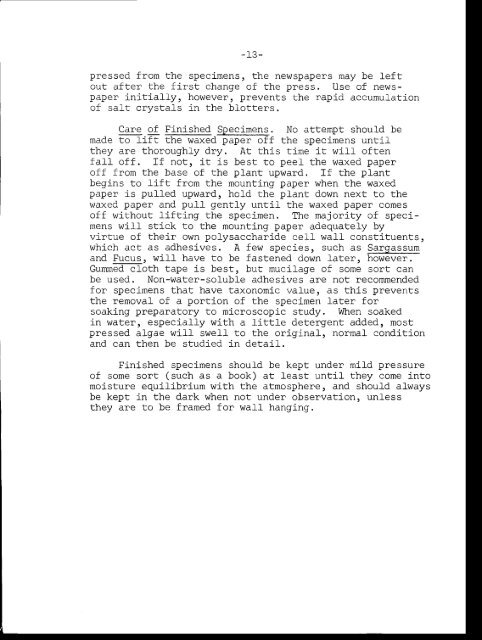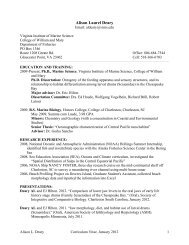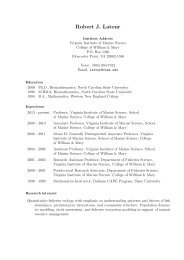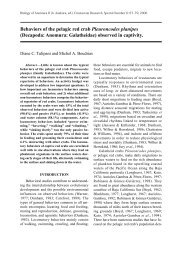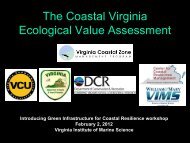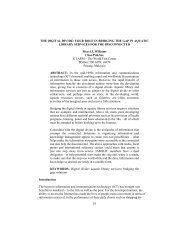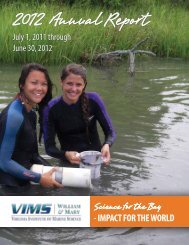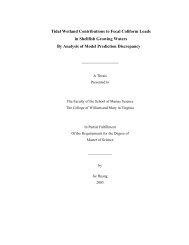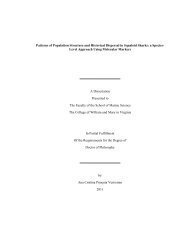Guide to the identification of marine plants and invertebrate animals ...
Guide to the identification of marine plants and invertebrate animals ...
Guide to the identification of marine plants and invertebrate animals ...
You also want an ePaper? Increase the reach of your titles
YUMPU automatically turns print PDFs into web optimized ePapers that Google loves.
_<strong>to</strong>_<br />
pressed from <strong>the</strong> specimens, <strong>the</strong> newspapers may be teft<br />
out after <strong>the</strong> fi-rst change <strong>of</strong> <strong>the</strong> press. Use <strong>of</strong> news-<br />
DaDer<br />
t,sl/er<br />
-i ni ]-i a I I rz lrnr.rar;ar nralTppf q<br />
arrrefs++J,<br />
vulrer <strong>the</strong> srru lani !ut/+u fl aCCUmUl_atjOn<br />
<strong>of</strong> sal-t crystals<br />
t<br />
}/Lv<br />
in <strong>the</strong> bl-otters.<br />
Care <strong>of</strong> Finished SDecimens. No attemDt shoul-d be<br />
. :----:.-- :=made<br />
<strong>to</strong> lift <strong>the</strong> waxed paper <strong>of</strong>f <strong>the</strong> specimens until<strong>the</strong>v<br />
ale thoror'^L'r.' ^-.' n* Lrrey q! s Lrrv! vuYrrJy vL y . nL this time it will_ <strong>of</strong>ten<br />
fal-i- <strong>of</strong>f. If not, it is best <strong>to</strong> peel <strong>the</strong> waxed paper<br />
<strong>of</strong>f from <strong>the</strong> base <strong>of</strong> <strong>the</strong> plant upward. If <strong>the</strong> plant<br />
begins <strong>to</strong> lift from <strong>the</strong> mounti-ng paper when <strong>the</strong> waxed<br />
paper is pulled upward, hold <strong>the</strong> plant down next <strong>to</strong> <strong>the</strong><br />
waxed paper <strong>and</strong> pull- gently until <strong>the</strong> waxed paper comes<br />
<strong>of</strong>f without l-ifting <strong>the</strong> specimen. The majority <strong>of</strong> specimens<br />
wi-li- stick <strong>to</strong> <strong>the</strong> mounting paper adequately by<br />
virtue <strong>of</strong> <strong>the</strong>ir own polysaccharide cell- wal-l- constituents,<br />
which act as adhesives. A few species, such as Sargassum<br />
<strong>and</strong> Fucus, will have <strong>to</strong> be fastened down later, however.<br />
Gummed cloth tape is best, but mucilage <strong>of</strong> some sort can<br />
be used. Non-water-sol-uble adhesives are not recommended<br />
for specimens that have taxonomj-c va1ue, as this prevents<br />
<strong>the</strong> removal <strong>of</strong> a portion <strong>of</strong> <strong>the</strong> specimen l-ater for<br />
soaking prepara<strong>to</strong>ry <strong>to</strong> microscopic study. When soaked<br />
in water, especiatty with a l-ittl-e detergent added, most<br />
pressed algae will- swel-l- <strong>to</strong> <strong>the</strong> original, normal condition<br />
<strong>and</strong> can <strong>the</strong>n be studied in detail.<br />
Finished specimens shoul-d be kept under mild pressure<br />
<strong>of</strong> some sort (such as a book) at least until- <strong>the</strong>y come in<strong>to</strong><br />
moisture equilibrium with <strong>the</strong> atrnosphere, <strong>and</strong> shoul-d always<br />
be kept in <strong>the</strong> dark when not under observation, unless<br />
<strong>the</strong>y are <strong>to</strong> be framed f or wal-l- hanging.


